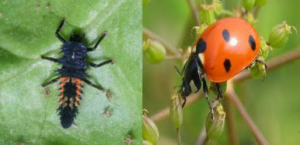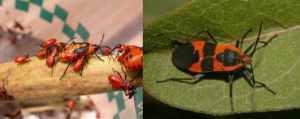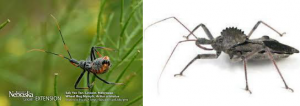READY TO GET STARTED?
REQUEST A FREE ESTIMATE
Fill out the form below or call (888) 466-7849 for a free, no-obligation estimate.
Spring is a time when everything comes to life, blooming into an array of lovely colors. You’ll see flowers that are pink and purple, baby bunnies that are tan or gray and insects that are red and black. Just like every other little life form emerging this time of year, insects can also be a variety of colors and it’s important not to get them confused. Some bugs you might spot frequently are of the Georgia Bulldog variety – red and black spots, stripes and even a combination of both.
If any of these insects or other pests become too much of nuisance, Northwest Exterminating has the expertise and knowledge to take care of your bug problems. Our Director of Pest Services Adam Vannest has provided some information about these bugs that will help you know the difference and what measures to take against them.
Lady Bug
 – Beneficial insect
– Beneficial insect
– Overwinters
– Feeds on aphids
– Control Measures: exclusion and vacuuming for long-term prevention. When necessary, chemical contact treatments can knock down a population
Box Elder Bug
– Overwinters
– Female: Box Elder trees and Silver Maple trees serve as the primary host plant
– Control Measures: Exclusion and a contact/residual application around the foundation and base of host plant
Milkweed Bug
 – Found in gardens on Milkweed plants or around shelled sunflower seeds
– Found in gardens on Milkweed plants or around shelled sunflower seeds
– Control Measures: Over-the-counter garden insecticides
Leaf-Footed Stink Bug
– Feeds on a wide variety of host plants
– Besides birds, they do not have too many natural predators due to their taste and smell
– Control Measures: Over-the-counter insecticides for garden areas. Outside of the garden, any contact or residual product labeled for stink bugs
Wheel Bug

– Semicircular cogwheel-like crest on its thorax
– Feeds on a wide variety of insects including caterpillars, beetles, aphids
Control Measures: Prevention is the key! All plants should be inspected before they enter the home. Exclusion should be performed for long-term prevention. All vegetation should be trimmed away from the home, at least one foot. Pesticides are rarely needed
We’ve gotten a lot of questions and phone calls regarding the ladybug larva. So here’s a quick run down for those of you that are experiencing ladybug larva around your property.
The female ladybug will lay her eggs on the undersides of leaves where there is a lot of food (aphids). The eggs will hatch three to five days later.
When you think about what a baby ladybug might look like, you probably think of a small cute version of the adult, right? Well, lets just say that a baby ladybug (larva) lives up to the saying “A face only a mother could love”. Baby ladybugs (ladybug larvae) are long and black with orange markings on its back, a little spikey looking and some say that they resemble alligators, but a whole lot smaller of course! I don’t see that but you can let your imagination go…
For more information on ladybugs or ladybug larva, call the experts at www.callnorthwest.com.
Adam Vannest
Director of Pest Services
Northwest Exterminating
 Director of Pest Services at Northwest Exterminating, Adam Vannest, was recently featured in Pest Management Professional magazine. Adam answered some Q and A’s regarding fleas and ticks and also gave some Do’s and Don’ts for when dealing with these pesky pests.
Director of Pest Services at Northwest Exterminating, Adam Vannest, was recently featured in Pest Management Professional magazine. Adam answered some Q and A’s regarding fleas and ticks and also gave some Do’s and Don’ts for when dealing with these pesky pests.
Read below to get the full story:
Adam Vannest, director of pest services for the Atlanta area’s Northwest Exterminating, has faced plenty of hard-to-solve flea and tick problems. He recently shared tales of some memorable infestations — and his team’s solutions — with Pest Management Professional.
Q: What’s the largest flea and tick infestation you’ve faced, and how did you conquer the pests?
Vannest: One of the largest was in a rural subdivision that backed up into a large wooded area. The customer reported dealing with an intense flea problem and said she’d also noticed multiple ticks on the family dog. Seeing ticks on her children was this customer’s threshold point.
While inspecting the outside we noticed a lot of the areas around the home were overgrown. There were tall weeds and grass up against the house and woodpiles around the exterior. We started looking at the ticks’ harborage sites to figure out why they would be attracted to the location. It was a three-story house on a crawlspace, and once inside we noticed the crawlspace door was already open. There were also other entry points because it wasn’t sealed up very well. We definitely found fleas in the crawlspace. The main floor and upstairs also had fleas.
We explained to the customer that we wanted to eliminate harborage areas around the outside by cutting down weeds and trimming the grass around the foundation. We also educated the homeowner about the crawlspace and how many entry points were visible to stray animals and rodents. We had an exclusion team come out and seal up those areas so that we could treat it with a residual product and an insect growth regulator (IGR).
Next, we explained to the customer that to get our product were it needs to be we’d have to remove everything from the floor for cleaning and vacuuming. We also instructed them to take the dog to the vet for treatment. After that, we applied a broadcast treatment to the floor surfaces and throughout the house.
We had to treat the lawn for ticks as well.
Q:What’s your hardest-to-find flea and tick story. How did you solve the problem?
Vannest: It took place at a ranch house on a crawlspace. When we inspected we noticed that the family pets were pest free. This told us we were dealing with a population in the home that had been carried inside by other means.
Sometimes people forget all of the other things that can be responsible for bringing fleas into a home. Some of the hardest flea problems to solve are ones where a rodent population carries them inside.
We inspected the rest of the house and found pockets of flea activity but no defined area. However, when we got to the attic level we found a roof rat population bringing in fleas from outside, so we applied residual products and treatments there to eliminate the rodent problem. When we placed monitors to determine where flea hot spots existed we found a few more harborage sites that had been egg-laying areas. We targeted those areas and eliminated the problem.
Adam Vannest’s Dos & Don’ts
Do
■ Train technicians to always think outside the box. Every flea situation and every tick situation can be different.
■ Know your products and which ones are best for a particular infestation. Read labels and test the products.
■ Use monitoring to help find hot spots.
Don’t
■ Don’t assume the customer is doing the prep work.
■ Don’t assume every situation is going to be the same.
■ Don’t stop educating your technicians. Give them ongoing training.
You can visit Pest Management Professional magazine by going to www.mypmp.net
Note: We will link directly to the article as soon as it is available online!
 Northwest Exterminating is proud to introduce Adam Vannest as our new Director of Pest Services. As Director of Pest Services, Adam will be responsible for all of the ongoing pest control training and development at Northwest. Adam has a strong commitment to excellence and continuing education; this passion will help Northwest to further their commitment to creating healthier living and working environments.
Northwest Exterminating is proud to introduce Adam Vannest as our new Director of Pest Services. As Director of Pest Services, Adam will be responsible for all of the ongoing pest control training and development at Northwest. Adam has a strong commitment to excellence and continuing education; this passion will help Northwest to further their commitment to creating healthier living and working environments.
Adam is a graduate of Kennesaw State University where he studied Music Education. Adam grew up surrounded by family members in the pest control industry. So it was no surprise that after graduation Adam decided to follow in their footsteps. Adam joined the Northwest family in 2007 and most recently served as the Monroe Service Center Manager. He soon became a Georgia Certified Operator in both WDO and HPC categories. Through his hard work, dedication, and involvement in civic organization, community events, and associations, Adam has helped Northwest to be the leader in pest and termite control.
Adam currently resides in Monroe with his wife, Elica, his son, Leo, and are anxiously awaiting the arrival of a daughter in October!
Northwest is excited to have Adam on board in his new role!
You can contact Adam at [email protected]
Blogs by Adam:
How to Rid Yellow Jackets Using Glue Boards
10 Ways to Make Sure Your Home is Not Attractive to Rodents